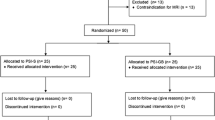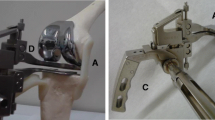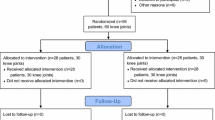Abstract
Purpose
Range of motion is a crucial measure of the outcome of total knee arthroplasty. Gap balancing technique and mobile-bearing prosthesis can improve postoperative range of motion. The purpose of this study was to determine the factors that are predictive of the postoperative range of motion.
Methods
A total of 94 knees with varus osteoarthritis were prospectively randomized to receive either a posterior-stabilized mobile-bearing or a posterior-stabilized fixed-bearing prosthesis. All preoperative and postoperative protocols and operative techniques were identical in the two groups. Extension and flexion joint gaps were measured using a tensor device during the operation. Multiple regression analysis was conducted to determine the best predictors of the knee flexion angle 2 years after the operation. The independent variables were type of prosthesis (mobile-bearing or fixed-bearing), difference between flexion and extension joint gaps (mm), age, gender, body mass index (BMI), preoperative and intraoperative knee flexion angles, change in posterior condylar offset, and posterior tilt of the tibial plateau.
Results
The mean difference between flexion and extension joint gaps was 0.8 ± 1.3 (mean ± SD) mm for mobile-bearing and 0.8 ± 1.9 mm for fixed-bearing prosthesis. The mean flexion angle for mobile-bearing and fixed-bearing groups was 120 ± 16° and 116 ± 20° preoperatively (n.s.), 142 ± 9° and 141 ± 12° intraoperatively (n.s.), and 129 ± 10° and 128 ± 13° at 2 years postoperatively (p = 0.773), respectively. Predictors were identified in the following three categories: (1) preoperative flexion angle, (2) intraoperative radiographic flexion angle, and (3) BMI (R = 0.603, p < 0.001).
Conclusions
Mobile-bearing prosthesis and optimal gap balancing did not result in superior postoperative flexion angle. Better preoperative and intraoperative flexion angles and lower BMI were the significant predictors for better postoperative flexion angle.
Level of evidence
Therapeutic study, Level I.


Similar content being viewed by others
References
Acker SM, Cockburn RA, Krevolin J et al (2011) Knee kinematics of high-flexion activities of daily living performed by male Muslims in the Middle East. J Arthroplasty 26:319–327
Asano H, Hoshino A, Wilton TJ (2004) Soft-tissue tension total knee arthroplasty. J Arthroplasty 19:558–561
Bellemans J, Banks S, Victor J, Vandenneucker H, Moemans A (2002) Fluoroscopic analysis of the kinematics of deep flexion in total knee arthroplasty. Influence of posterior condylar offset. J Bone Jt Surg 84-B:50–53
Bistolfi A, Massazza G, Lee GC, Deledda D, Berchialla P, Crova M (2013) Comparison of fixed and mobile-bearing total knee arthroplasty at a mean follow-up of 116 months. J Bone Jt Surg 95-A:e83. doi:10.2106/JBJS.L.00327
Callaghan JJ, Insall JN, Greenwald AS et al (2001) Mobile bearing knee replacement: concepts and results. Instr Course Lect 50:431–449
Chen LB, Tan Y, Al-Aidaros M, Wang H, Wang X, Cai SH (2013) Comparison of functional performance after total knee arthroplasty using rotating platform and fixed-bearing prostheses with or without patellar resurfacing. Orthop Surg 5:112–117
Delport HP, Banks SA, De Schepper J et al (2006) A kinematic comparison of fixed-and mobile-bearing knee replacements. J Bone Jt Surg 88-B:1016–1021
Dennis DA, Komistek RD, Scuderi GR, Zingde S (2007) Factors affecting flexion after total knee arthroplasty. Clin Orthop Relat Res 464:53–60
Dennis DA, Komistek RD, Kim RH, Sharma A (2010) Gap balancing versus measured resection technique for total knee arthroplasty. Clin Orthop Relat Res 468:102–107
Ewald FC (1989) The knee society total knee arthroplasty roentgenographic evaluation and scoring system. Clin Orthop Relat Res 248:9–12
Harvey IA, Barry K, Kirby SP, Johnson R, Elloy MA (1993) Factors affecting the range of movement of total knee arthroplasty. J Bone Jt Surg 75-B:950–955
Higuchi H, Hatayama K, Shimizu M et al (2009) Relationship between joint gap difference and range of motion in total knee arthroplasty: a prospective randomised study between different platforms. Int Orthop 33:997–1000
Insall J, Dorr L, Scott R, Scott W (1989) Rationale of the knee society clinical rating system. Clin Orthop Relat Res 248:13–14
Ishii Y, Noguchi H, Takeda M, Sato J, Toyabe S (2011) Prediction of range of motion 2 years after mobile-bearing total knee arthroplasty: PCL-retaining versus PCL-sacrificing. Knee Surg Sports Traumatol Arthrosc 19:2002–2008
Jennings LM, Bell CI, Ingham E et al (2007) The influence of femoral condylar lift-off on the wear of artificial knee joints. Proc Inst Mech Eng H 221:305–314
Joseph J, Simpson PM, Whitehouse SL, English HW, Donnelly WJ (2013) The use of navigation to achieve soft tissue balance in total knee arthroplasty—a randomised clinical study. Knee. doi:10.1016/j.knee.2013.06.007
Koshino T, Tsuchiya K (1979) The effect of high tibial osteotomy on osteoarthritis of the knee. Clinical and histological observations. Int Orthop 3:37–451
Kim TK, Kwon SK, Kang YG, Chang CB, Seong SC (2010) Functional disabilities and satisfaction after total knee arthroplasty in female Asian patients. J Arthroplasty 25:458–464
Kim YH, Sohn KS, Kim JS (2005) Range of motion of standard and high-flexion posterior stabilized total knee prostheses. A prospective, randomized study. J Bone Jt Surg 87-A:1470–1475
Kurita M, Tomita T, Yamazaki T et al (2012) In vivo kinematics of high-flex mobile-bearing total knee arthroplasty, with a new post-cam design, in deep knee bending motion. Int Orthop 36:2465–2471
Lee DH, Lee DK, Shin YS, Han SB (2013) Influence of gap balance on the sagittal movement of a specific mobile bearing floating platform design in total knee arthroplasty. J Arthroplasty. doi:10.1016/j.arth.2013.04.019
Matsuda S, Kawahara S, Okazaki K, Tashiro Y, Iwamoto Y (2013) Postoperative alignment and ROM affect patient satisfaction after TKA. Clin Orthop Relat Res 471:127–133
Matsumoto T, Kuroda R, Kubo S et al (2009) The intra-operative joint gap in cruciate-retaining compared with posterior-stabilised total knee replacement. J Bone Jt Surg 91-B:475–480
Matsumoto T, Muratsu H, Kubo S et al (2011) Soft tissue balance measurement in minimal incision surgery compared to conventional total knee arthroplasty. Knee Surg Sports Traumatol Arthrosc 19:880–886
Matziolis G, Pfiel S, Wassilew G, Boenicke H, Perka C (2011) Kinematic analysis of the flexion axis for correct femoral component placement. Knee Surg Sports Traumatol Arthrosc 19:1504–1509
Minoda Y, Iwaki H, Ikebuchi M, Yoshida T, Nakamura H (2012) The flexion gap preparation does not disturb the modified gap technique in posterior stabilized total knee arthroplasty. Knee 19:832–835
Pang HN, Yeo SJ, Chong HC et al (2011) Computer-assisted gap balancing technique improves outcome in total knee arthroplasty, compared with conventional measured resection technique. Knee Surg Sports Traumatol Arthrosc 19:1496–1503
Parsley BS, Engh GA, Dwyer KA (1992) Preoperative flexion. Does it influence postoperative flexion after posterior-cruciate-retaining total knee arthroplasty? Clin Orthop Relat Res 275:204–210
Ritter MA, Harty LD, Davis KE, Meding JB, Berend ME (2003) Predicting range of motion after total knee arthroplasty. Clustering, log-linear regression, and regression tree analysis. J Bone Jt Surg 85-A:1278–1285
Ritter MA, Campbell ED (1987) Effect of range of motion on the success of a total knee arthroplasty. J Arthroplasty 2:95–97
Ritter MA, Stringer EA (1979) Predictive range of motion after total knee replacement. Clin Orthop Relat Res 143:115–119
Russell RD, Huo MH, de Jong L, Jones RE (2013) Preoperative flexion does not influence postoperative flexion after rotating-platform total knee arthroplasty. Knee Surg Sports Traumatol Arthrosc. doi:10.1007/s00167-013-2378-2
Sansone V, de Gama Malchèr M (2004) Mobile-bearing total knee prosthesis: a 5- to 9-year follow-up of the first 110 consecutive arthroplasties. J Arthroplasty 219:678–685
Smith H, Jan M, Mahomed NN, Davey JR, Gandhi R (2011) Meta-analysis and systematic review of clinical outcomes comparing mobile bearing and fixed bearing total knee arthroplasty. J Arthroplasty 26:1205–1213
Smith TO, Ejtehadi F, Nichols R et al (2010) Clinical and radiological outcomes of fixed- versus mobile-bearing total knee replacement: a meta-analysis. Knee Surg Sports Traumatol Arthrosc 18:325–340
Tibesku CO, Daniilidis K, Vieth V et al (2011) Sagittal plane kinematics of fixed- and mobile-bearing total knee replacements. Knee Surg Sports Traumatol Arthrosc 19:1488–1495
Wen Y, Liu D, Huang Y, Li B (2011) A meta-analysis of the fixed-bearing and mobile-bearing prostheses in total knee arthroplasty. Arch Orthop Trauma Surg 131:1341–1350
Author information
Authors and Affiliations
Corresponding author
Rights and permissions
About this article
Cite this article
Minoda, Y., Iwaki, H., Ikebuchi, M. et al. Mobile-bearing prosthesis and intraoperative gap balancing are not predictors of superior knee flexion: a prospective randomized study. Knee Surg Sports Traumatol Arthrosc 23, 1986–1992 (2015). https://doi.org/10.1007/s00167-014-2838-3
Received:
Accepted:
Published:
Issue Date:
DOI: https://doi.org/10.1007/s00167-014-2838-3




